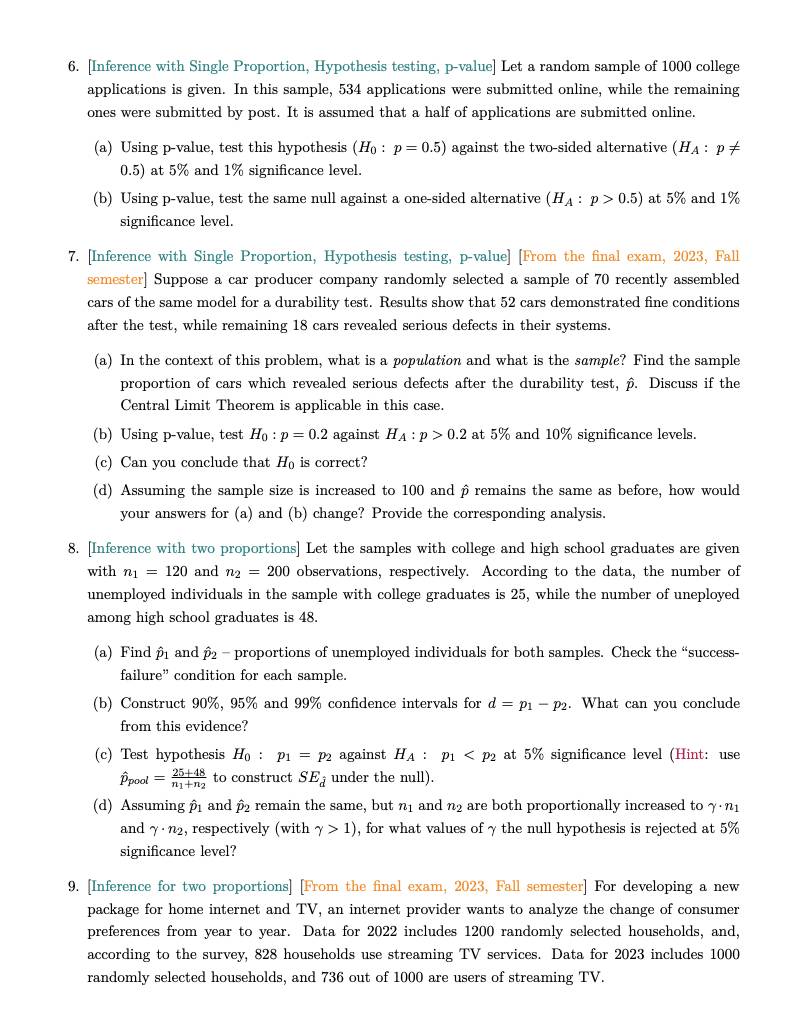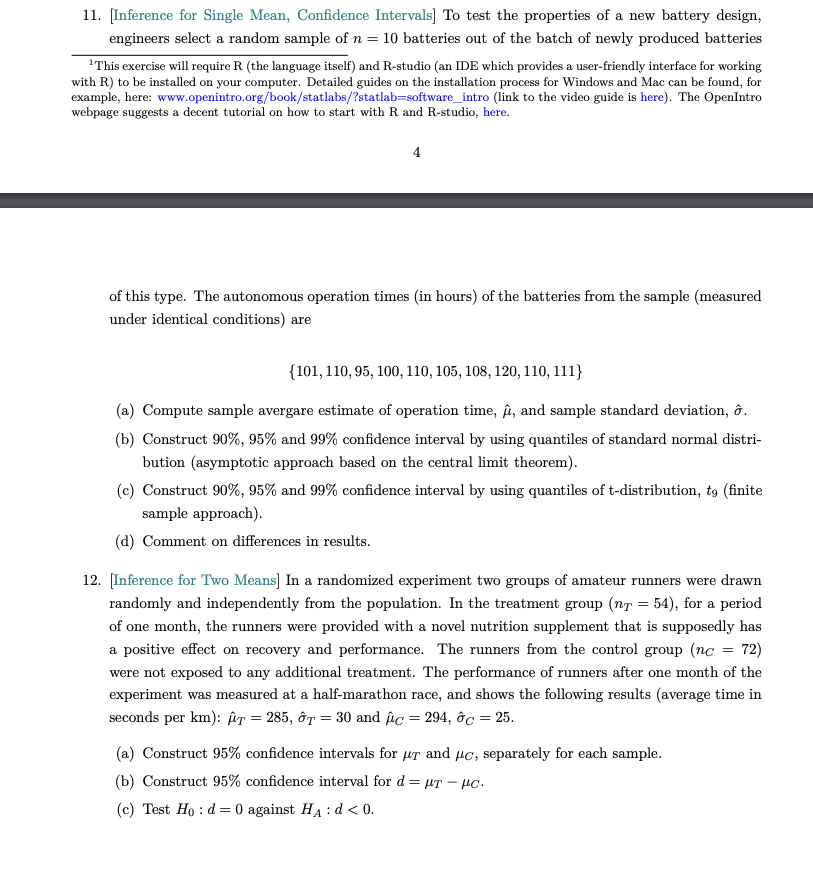Answered step by step
Verified Expert Solution
Question
1 Approved Answer
6. [Inference with Single Proportion, Hypothesis testing, p-value] Let a random sample of 1000 college applications is given. In this sample, 534 applications were



6. [Inference with Single Proportion, Hypothesis testing, p-value] Let a random sample of 1000 college applications is given. In this sample, 534 applications were submitted online, while the remaining ones were submitted by post. It is assumed that a half of applications are submitted online. (a) Using p-value, test this hypothesis (Ho: p = 0.5) against the two-sided alternative (HA: p 0.5) at 5% and 1% significance level. (b) Using p-value, test the same null against a one-sided alternative (HA p > 0.5) at 5% and 1% significance level. 7. [Inference with Single Proportion, Hypothesis testing, p-value] [From the final exam, 2023, Fall semester] Suppose a car producer company randomly selected a sample of 70 recently assembled cars of the same model for a durability test. Results show that 52 cars demonstrated fine conditions after the test, while remaining 18 cars revealed serious defects in their systems. (a) In the context of this problem, what is a population and what is the sample? Find the sample proportion of cars which revealed serious defects after the durability test, p. Discuss if the Central Limit Theorem is applicable in this case. (b) Using p-value, test Ho: p = 0.2 against HA: p > 0.2 at 5% and 10% significance levels. (c) Can you conclude that Ho is correct? (d) Assuming the sample size is increased to 100 and p remains the same as before, how would your answers for (a) and (b) change? Provide the corresponding analysis. 8. [Inference with two proportions] Let the samples with college and high school graduates are given with n = 120 and n = 200 observations, respectively. According to the data, the number of unemployed individuals in the sample with college graduates is 25, while the number of uneployed among high school graduates is 48. (a) Find 1 and 2-proportions of unemployed individuals for both samples. Check the "success- failure" condition for each sample. (b) Construct 90%, 95% and 99% confidence intervals for d = p - p2. What can you conclude from this evidence? : : (c) Test hypothesis Hop = p2 against HA p < p2 at 5% significance level (Hint: use Ppool 25+48 to construct SE under the null). = n1+n2 (d) Assuming 1 and 2 remain the same, but n and n2 are both proportionally increased to y.ni andy.n2, respectively (with > 1), for what values of the null hypothesis is rejected at 5% significance level? 9. [Inference for two proportions] [From the final exam, 2023, Fall semester] For developing a new package for home internet and TV, an internet provider wants to analyze the change of consumer preferences from year to year. Data for 2022 includes 1200 randomly selected households, and, according to the survey, 828 households use streaming TV services. Data for 2023 includes 1000 randomly selected households, and 736 out of 1000 are users of streaming TV. significance level? 9. [Inference for two proportions] [From the final exam, 2023, Fall semester] For developing a new package for home internet and TV, an internet provider wants to analyze the change of consumer preferences from year to year. Data for 2022 includes 1200 randomly selected households, and, according to the survey, 828 households use streaming TV services. Data for 2023 includes 1000 randomly selected households, and 736 out of 1000 are users of streaming TV. 3 (a) Construct a contingency table fot this data (Hint: 2x2 table where rows correspond to year and columns correspond to streaming TV usage). (b) Compute the sample proportions of streaming TV users, 2022 and 2023, and also the sample proportion change between 2022 and 2023, d = p2023 - 2022. (c) Denote d = p2023 - P2022 (population change), and write down the Central Limit Theorem for - d. Discuss, if the Central Limit Theorem can be applied in this case. (d) Construct the 99% confidence interval for d. (e) Test Ho P2023 = P2022 against HA P2023 > P2022 at 5% significance level. (Hint: use the pooled proportion estimate, pool, to compute the standard error under the null). 10. [R and R-studio] For the current exercise you work with the UK Smoking Data that can be downloaded from the OpenIntro webpage (here). Scroll down and download the CSV-file with the smoking data. In the R-studio, the data can be simply loaded from this file by using command data 11. [Inference for Single Mean, Confidence Intervals] To test the properties of a new battery design, engineers select a random sample of n = 10 batteries out of the batch of newly produced batteries This exercise will require R. (the language itself) and R-studio (an IDE which provides a user-friendly interface for working with R) to be installed on your computer. Detailed guides on the installation process for Windows and Mac can be found, for example, here: www.openintro.org/book/statlabs/?statlab-software_intro (link to the video guide is here). The OpenIntro webpage suggests a decent tutorial on how to start with R and R-studio, here. 4 of this type. The autonomous operation times (in hours) of the batteries from the sample (measured under identical conditions) are {101, 110, 95, 100, 110, 105, 108, 120, 110, 111} (a) Compute sample avergare estimate of operation time, ^, and sample standard deviation, . (b) Construct 90%, 95% and 99% confidence interval by using quantiles of standard normal distri- bution (asymptotic approach based on the central limit theorem). (c) Construct 90%, 95% and 99% confidence interval by using quantiles of t-distribution, to (finite sample approach). (d) Comment on differences in results. 12. [Inference for Two Means] In a randomized experiment two groups of amateur runners were drawn randomly and independently from the population. In the treatment group (n = 54), for a period of one month, the runners were provided with a novel nutrition supplement that is supposedly has a positive effect on recovery and performance. The runners from the control group (nc = 72) were not exposed to any additional treatment. The performance of runners after one month of the experiment was measured at a half-marathon race, and shows the following results (average time in seconds per km): T = 285, T = 30 and c = 294, c = 25. (a) Construct 95% confidence intervals for T and c, separately for each sample. (b) Construct 95% confidence interval for d=T - HC. (c) Test Hod = 0 against Hd < 0.
Step by Step Solution
There are 3 Steps involved in it
Step: 1

Get Instant Access to Expert-Tailored Solutions
See step-by-step solutions with expert insights and AI powered tools for academic success
Step: 2

Step: 3

Ace Your Homework with AI
Get the answers you need in no time with our AI-driven, step-by-step assistance
Get Started


